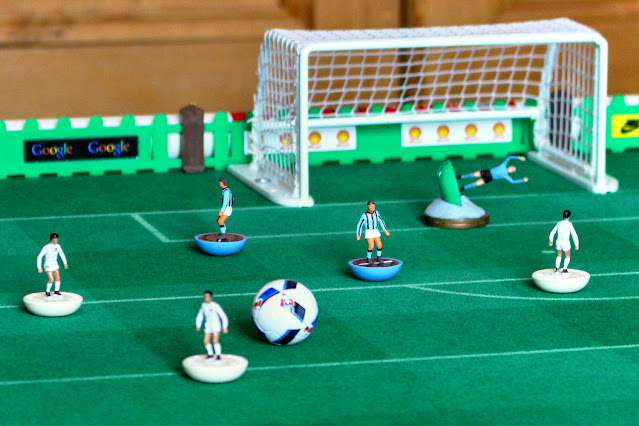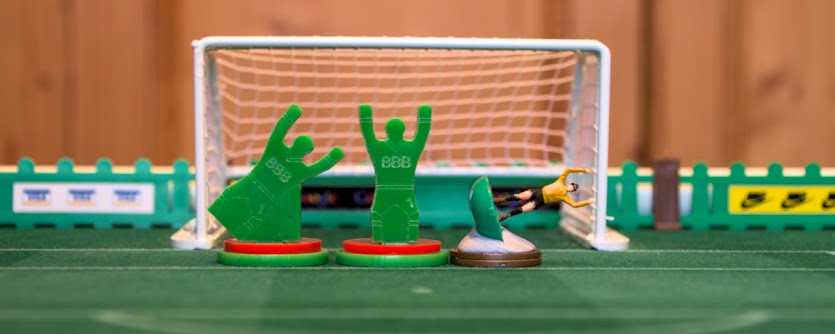The
next season of the Bonfire Alliance will again be underway sometime
around the middle of July. Why such a long break? Well other things
need my attention. Man cannot live by Subbuteo alone, and I’m sure
my long suffering Wife would agree with that statement. Also the
Euros will be in full flow, but shush don’t let my Wife know I want
it to be a surprise.
Next
seasons Bonfire Alliance fixtures have been generated, the first
round cup draw has been made, with the addition of 4 non league
teams, and all rule changes have been tested and written up. So
everything is in place to hit the ground running, but that is not why
you called.
The
rules changes I’ve made are not radical or ground breaking, they
are basically tweaks related to last seasons games. I didn’t want
to change the way I like to play, or have to remember a plethora of
new rules, I just want maximum enjoyment from my efforts. As is my
way I’ve not changed any core rules that have been present for
almost 75 years, but tweaked my house rules that allow me to play
solo.
Modified
Blocking Rules
Last
year I shared with you my blocking rules, but
after playing a full season with those rules, I decided that some
tweaking was necessary to lessen or should I say hopefully lessen the
goal tally slightly. My reasons for wanting to do this is purely a
personal preference to make the scores a little more (and I say this
tongue in cheek), believable.
Last
season my blocking rules were simple, once
the ball had been played by the attack inside the Shooting Area the
defence were allowed a blocking flick, and only gained another if the
goalkeeper touched the ball, or after a 2nd
touch by the attack in the
area after a set piece. Anytime the ball is
played out of the area resets
the blocking flick. Blocking flicks were also allowed by the defence
after the attack had an onside flick.
So
blocking flicks are
in limited supply and although
I feel that they are necessary I don't want
them disrupting
the flow of my solo games. One thing however that did crop up was the
amount of goals scored by attackers who
played the ball into the area and followed up with a shot before the
defence were allowed a block. One method I tried was allow a block as
soon as the ball was played into the area, this was better, but
stopped the majority of first time shots from the attacking team.
I
like the idea of the attack allowed a first time shot from an
accurate pass without the defence allowed to react but the above
method as stated would no longer allow this. So I had gone literally
from all to nothing. Yes it
reduced the number of goal bound chances, but had taken a little
spontaneity out of the game.
 |
The Covering block must end up behind the line of the ball
|
The
Covering Block
So
after a little head scratching (and scratching of other nameless
parts), I came up with the covering block. After play testing in some
mid season friendlies I found the following went some way to
achieving my goals, or in this case the desired reduction.
My
modified rule is basically the same, but if an attacker plays the
ball into the shooting area, that attacker
can still have a shot with
its next flick (providing it can), but
the attack must
wait for the defence to take their blocking flick before shooting.
This block I’ve called a
covering block and takes the place of the normal block. One thing
though the covering block must end up
between the line of the ball and its own goal line. If the defender
ends up in the in the area between the attacker now shooting and the
ball the defender is replaced to its former position and forfeits
their teams right to block until an opportunity arises again.
So
to sum that up:
An
attacker that plays the ball into the area and then
decides to shoot with it’s next flick, allows the
defence a covering block, and must wait for a covering
defensive block to be taken, (unless that attacker hits a
moving ball). This does not stop another attacker taking a
shot denying the defence a covering block.
A
covering
block
by the defence must end
up behind
the
line of
the
ball, if it doesn’t the defender is put back into it’s original
position and the block is lost.
The
modification is not a radical change, but in all the games I’ve
played this way it has seemed to have had the desired effect without
changing my gameplay too drastically.
So I have made a decision to
go with this method next season.
Making
Sense of Fouls
Under
my current regime all blocking flick misdemeanours are fouls, strike
an opponent
or the ball with a blocking flick and
a foul is committed. Nothing wrong with that in my world, I also
extended that courtesy to onside flicks, but I started to have doubts
after a defender contacted an attacker with
its onside block giving away
a penalty, only trouble was the attack had possession just outside
their own shooting area. Call
me old fashioned (you wouldn’t be the first), but that just didn’t
seem right to me. I awarded the penalty, cus dems the rules.
To
stop this happening next season Onside flicks only commit fouls if
the ball is contacted. At least if a foul is committed with an onside
flick the ball should be in theory in the same half. Again not a
drastic change but I feel a sensible one.
Positional
Flick Changes
Last
seasons rules stated that if a positional flick (corners, free kicks,
etc.) hit an opponent it was an automatic back. This season I’ve
scrapped that providing if contact is made the player that is knocked
isn’t displaced too far. Now how far is too far, I
think about 25mm is about as far as I will allow before I will award
a back.
Another
change I’ve made is with free kicks, and throw ins between the
shooting areas. Under these circumstances the attacking team can
decide to take a quick free kick of throw in by not allowing any
positional flicks. But only between the shooting areas,
any set piece within the confines of
either area will always be subject to positional flicks.
Goal
Kicks
I’ve
altered positioning at goal kicks, I was finding things becoming too
similar and the forwards
at times were not allowed to
press as they couldn’t get
placed
any
closer than 90mm from the
shooting line, and that was by design as my rules dictated. So now
I’m
allowing players inside their opponents shooting area to be placed
anywhere outside of the area, and
all other players
can be placed
no closer
than 90mm
away
from
their opponents shooting line.
To
be honest it’s not a drastic change, what it does allow is
attackers in the opposing
shooting areas to keep a high line. Conversely if a team is
concentrated in it’s own half players can be moved forward but must
be no closer
than 90mm
away
than their opponents shooting line. So now I’m not automatically
positioning players in sort
of set positions. If the forwards aren’t up there they cannot get
any closer than 90mm.
I’ve tried it in a few practice games and it has made for a
slightly more tactical game.
Finally
And
that’s about it, nothing ground breaking or life changing just an
attempt to make next season’s Bonfire Alliance another enjoyable
experience.
One
final note just to add a
little spice into the mix,
I’ve added a yellow card
system. Two fouls by a team
equates to one yellow card. Two yellow cards in a match and
the flicking goalkeeper gets an early bath. All yellow cards are
cumulative and at any point in the season a team acquires 5 yellow
cards, the flicking keeper misses the next match. Once a team
acquires 10 yellow cards the flicking keeper again misses the next
match and so on.
At
this point in time I’m having trouble recruiting flicking keepers
who now think they’re being victimised.
If
you’re interested in my modified solo rules they can be found Here or on the downloads
page.




Great blog Ian, for defensive flicks I use the 68 Rules so only 3 once attack in opposition half, unless the ball is passed backwards but all with the restriction you describe for the covering block. Ian are you on Facebook?
ReplyDeleteSorry that should "unless Ball is passed backwards the 3 are reset"
DeleteThanks for your comment, I have tried to get away from the 3 defensive flick regime to speed up my play, it suits me and my style of play. I know a few people that play your way or should I say the 60's way with great success. I tried it but found it was slowing me down a little too much. Since my youth I've always played continual blocking as they were the competition rules at the time. It's surprising how many solo players have similar ideas and rules to that of my own. If it works no need to change it eh!.
DeleteYes I am on Facebook, may I ask why your interested? I'm also a member of the ISF are you?
Thanks Ian so do you still use defensive flicks all over the field in your solo play like you did in competitive play?
ReplyDeleteI have come to realise I like many play a combination of rules taken from the Subbuteo rule books released by themselves in box sets so some from the 70's, 80's but then the defensive flicks from the 60's plus additional rules or adjustments to the original rules all to add to enjoyment and 'realism'. I was asking about Facebook as I set a group up back in March.
It is dedicated to those in the hobby who still like to play Subbuteo Table Football/Soccer either Solo or with Family and Friends to recreate/mimic association football either via teams representing real world clubs of any era or using fantasy teams. There are match reports, members competitions they are playing out, exchange of ideas on rules etc. So thought it might be of interest to you.
I think I found you on FB and have messaged you about it. So hopefully you got a message from Phil Marsden which is me.
I am not a member of the forum.